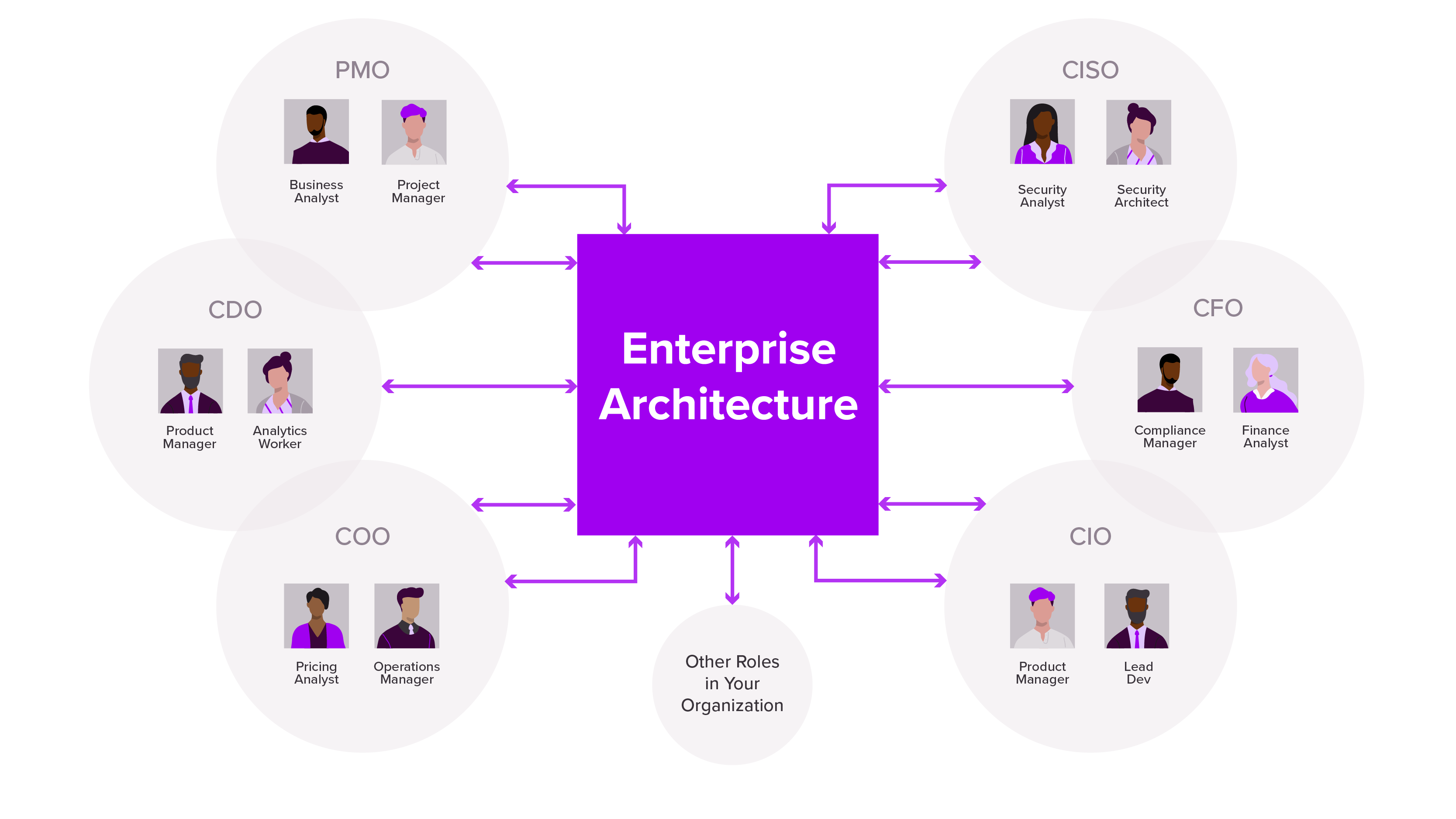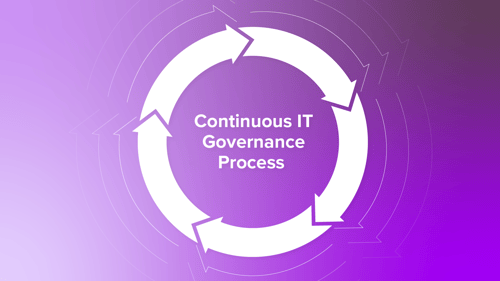In today's fast-paced business landscape, data is king. For Enterprise Architects, harnessing the power of efficient data collection and understanding data lineage is paramount to driving informed decision-making and achieving organizational goals. However, the data required to maintain trustworthy enterprise architecture doesn’t live solely with Enterprise Architects, nor can it only depend on third-party tools from which this data can be sourced. To get the complete picture based on reliable, up-to-date data, Enterprise Architects must identify missing data, determine the stakeholders to obtain this data from, and establish the frequency with which this data should be revisited.
If this challenge sounds familiar to you and you are seeking ideas and tools for when and how to collect information from the wider organization, this article is the place to start. We will cover the importance of effective data collection, provide a brief overview how the Ardoq platform’s Survey and Broadcast functionality eases data maintenance, and share some tips and examples of data crowdsourcing from the wider organization.
Common Challenges With Data Collection
- Manual process of collection in many organizations: Time-consuming and heavy burden on EA and IT organization
- Data is often out of date: Based on manual processes, so not reflective of the true picture of the organization most of the time. Hard to ensure the consistency, accuracy, and timeliness of data across diverse sources.
- No capacity for strategic work: EAs spend so much time chasing people down for data or governing data that they don't have the time or ability to quickly pull the meaningful insights that matter to decision-makers
- Dealing with data silos: Different departments within an organization often use their own systems and processes for managing data, leading to data silos. It becomes a challenge to EAs to break down these siloes and ensure a unified view of data across the organization is a significant challenge. This is both a technical challenge as well as one to do with organizational culture or structure.
- Increasing velocity and volumes of data: The amount of data keeps growing, which makes it even harder to keep up. Data is paramount to powering organizational agility and decision-making.
Benefits of Effective Data Collection From the Wider Organization
Effective data collection lays the foundation for strategic decision-making and organizational success. By maintaining accurate and up-to-date data, enterprise architects can:
- Gain Valuable Insights Into Their Organization’s Architecture Landscape: Manage low-value systems out of their IT portfolios and better control application investment.
- Identify Opportunities for IT Cost Optimization: Optimize their IT Investment Efficiency with Strategic Insights based on real time data.
- Mitigate potential risks: Increase transparency, assess technology risks, and ensure controls are in place, in a fraction of a time compared to traditional methods.
- Enable Data-driven Business Acceleration: Organizations with up-to-date data and insights at the fingertips of decision-makers are able to respond quickly to market changes, innovate effectively, and stay ahead of the competition.
Learn how our CISO tracks all new potential risks associated with new software without becoming a bottleneck in the purchasing process.
For more insight into outcomes a data-driven EA platform can help businesses achieve, read “Top 7 Business Outcomes You Can Expect With Ardoq”.

15 Ideas for Enterprise Architects on When to Collect Data From Stakeholders
Over the last ten years, we have observed the many instances where EA teams interact with the wider organization to engage them in updating their enterprise architecture.
Here are some examples to inspire you with your data collection and governance efforts:
- Stakeholder Feedback and Alignment: Gathering feedback from diverse stakeholders across departments, business units, and geographical locations to ensure alignment with organizational objectives and priorities.
- Enterprise-wide Requirements Gathering: Collecting requirements from various business units and departments for large-scale enterprise-wide initiatives, ensuring comprehensive coverage and alignment with business needs.
- Risk Assessment: Conducting risk assessments by soliciting input from relevant stakeholders on potential risks and vulnerabilities. Learn how HMCTS is conducting better risk management.
- Compliance Checks: Ensuring compliance with industry standards and regulations, such as GDPR, by conducting compliance checks via targeted surveys. Read about how BOS has leveraged our platform to empower teams outside the IT organization to conduct GDPR processing more efficiently.
- Performance Monitoring: Monitoring the performance of architecture solutions and systems by gathering feedback from the stakeholders. Learn how public sector organizations, such as Askoy Kommune, have gained a complete overview of their technology and business processes performance with the help of Ardoq and Power Bi.
- Budget Planning: Gathering input from stakeholders on budgetary requirements and resource allocations for their projects and initiatives.
- Cost Reduction Initiatives Prioritization: Prioritizing cost reduction initiatives by gathering input from stakeholders on cost-saving opportunities, potential risks, and implementation feasibility.
- Vendor and Supplier Relationship Management: Assessing vendor and supplier performance across the enterprise, gathering feedback on service quality, contract compliance, and overall satisfaction to optimize vendor relationships and mitigate risks.
- Vendor Assessment: Assessing vendor performance and satisfaction through targeted surveys and feedback mechanisms.
- Continuous Improvement: Driving continuous improvement initiatives by regularly collecting feedback from stakeholders on architecture processes, practices, and performance metrics.
- Supporting Large Digital Transformation Projects: Collecting information about existing digital capabilities from various business units and departments. This could include evaluating existing technology stacks, skill sets within teams, and current levels of digital maturity. Learn how organizations with 17,000+ employees managed to automate workflows, crowdsourcing, and maintaining data related to people, roles, vacancies, and recruitment.
- Strategic Planning and Alignment: Engaging stakeholders in strategic planning processes at an enterprise level, gathering input on strategic goals, priorities, and initiatives to ensure alignment with organizational objectives and maximize effectiveness.
- Innovation and Ideation: Fostering a culture of innovation by soliciting ideas and suggestions from employees across the enterprise, driving creativity and generating new opportunities for growth and differentiation.
- Knowledge Sharing and Collaboration: Promoting knowledge sharing and collaboration among employees by facilitating surveys on knowledge management practices, collaboration tools, and communication channels.
- Corporate Social Responsibility (CSR) Initiatives: Gathering input from stakeholders on CSR initiatives and sustainability practices, ensuring alignment with corporate values, and driving positive social and environmental impact across the enterprise.
If you’re looking for the best place to start, we recommend you begin by automating your application ownership process. Manufacturing companies like Bertel O. Steen, have achieved great results by automating application ownership processes that have greatly supported their GDPR initiatives.
Combining years of domain expertise with customer feedback, Ardoq’s team of in-house Enterprise Architects have built this template to help you start from scratch by identifying potential stakeholders, assets, and processes they’re responsible for.
How Ardoq Surveys and Broadcasts Bring These Ideas to Life
We know the information collection process is often painful so our platform is meant to make it easy for Enterprise Architects to set up and scale. Our powerful Engagement modules, Ardoq Surveys and Broadcasts, are instrumental in streamlining data collection and maintenance from stakeholders.
Surveys
Ardoq Surveys gathers information from the wider organization into a single enterprise knowledge base in the Ardoq platform. It allows administrators to build custom, targeted surveys and have them sent to the relevant people in the organization. It keeps enterprise information up to date automatically based on the input of survey contributors, making follow-ups at set intervals as required.
Broadcasts
Ardoq Broadcasts are designed to help automate data collection processes and notify stakeholders about changes in information that is important and relevant to them. Broadcasts replace manual searching and outreach to key contributors with intelligent, automated workflows triggered by changes in the architecture.
Unlike traditional data collection methods, such as email surveys, interviews, or manual data entry, Surveys used together with Broadcasts enable Enterprise Architects to reach a wide audience quickly and receive timely feedback. Set up once and running automatically in the background, these tools help Enterprise Architects keep their focus on impactful tasks.
Better Governance With Automation
A few weeks before manual interviews should have started, the team realized that Ardoq could leverage Surveys and Broadcasts to automate the process. They estimated they could put everything into the tool around the same time it took to run the process. Within three days, they had the implementation in place. They have the engagement layer, reporting layer, scoring, and translation all in the tool. They’re actively using it today.
Learn more about resolving technical debt with Enterprise Architecture Portfolio Management and automation.
Additionally, EAs get access to a centralized platform for managing survey responses, analyzing data, and generating actionable insights.
Would you like to gain a better understanding of how these tools can help you engage a wider audience in your organization? In our Survey Broadcast Use Cases article, you’ll find practical examples of how these features work together, along with the messaging templates you can use to motivate colleagues to update information.
Can’t wait to see how this can work with your own data?
Best Practices for Implementation
Here are a few tips for you to keep in mind when getting started with organization-wide data collection.
- Start small by clearly defining objectives and target audience to ensure relevance and effectiveness.
- Find sponsors within your organization units, from where you’re planning to collect information.
- Design concise and user-friendly data collection surveys to maximize participation and engagement among stakeholders (max 10 questions.)
- Continuously monitor stakeholder engagement to assess their participation and contributions, providing sponsors with the insights into the level of involvement of each organization unit and keep them up to date about the effectiveness of the survey initiatives.
- Explore the possibility of gamifying participation. Consider offering rewards and recognition for those who respond promptly and actively contribute.
- Foster a culture of transparency, collaboration, and innovation by leveraging your digital transformation solution as a platform for ongoing dialogue and engagement with stakeholders.
The Key to Building an Effective, Democratized Enterprise Architecture
“It's not only IT but also the business side that uses this. You could say that it builds a bridge between the two.”
- Per-Christian Aubert, Head of Integrations and Architecture at BOS
Ardoq's engagement features are crucial components of the enterprise management engine that innovative Enterprise Architects are tasked to build to drive large-scale, fast-moving digital transformation initiatives in their organizations. From day zero, the Ardoq team of experts partners with our customers, guiding them in crafting this engine to precisely meet their organization's needs, whether it’s minimizing risks, reaching their growth goals, or minimizing costs.
Check out Ardoq's free guides on how to communicate the value of your EA initiatives and get business buy-in.
Alternatively, get in touch with our team today to discuss your goals and challenges.
 Anastasia Titova
Our product marketing champion for Ardoq’s engagement features, Anastasia, has thirteen years of experience across both product and marketing domains. She is driven by a deep commitment to understanding customer needs and converting product capabilities into clear, user-focused values.
Anastasia Titova
Our product marketing champion for Ardoq’s engagement features, Anastasia, has thirteen years of experience across both product and marketing domains. She is driven by a deep commitment to understanding customer needs and converting product capabilities into clear, user-focused values.






/Logos/Ardoq/RGB_Ardoq_Logo_Stacked_White_Monochrome%201.png?width=80&height=77&name=RGB_Ardoq_Logo_Stacked_White_Monochrome%201.png)

